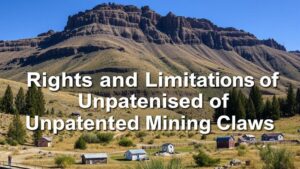How Wooden Structures Were Used to Shore Up Early Mining Shafts
How Wooden Structures Were Used to Shore Up Early Mining Shafts
The mining industry has a longstanding history of advancements and techniques designed to ensure the safety and efficiency of operations. Among these methods, wooden structures played a pivotal role in shoring up early mining shafts. This article explores the significance, application, and evolution of wooden supports in mining operations.
The Importance of Shaft Support
Mining involves digging tunnels and shafts deep into the earth to access valuable minerals and metals. But, these excavations are susceptible to collapsing due to the weight of the overlying soil and rock. Early miners faced significant dangers, such as cave-ins and falling debris, making effective shaft support essential. Wooden structures provided an innovative solution that addressed both safety and practicality.
Wooden supports, primarily made from timber, were utilized in various forms throughout mining history. Common types of wooden structures included:
- Timber Sets: Vertical posts and horizontal beams were used to create a grid-like structure, offering stability and preventing collapses.
- Lagging: Wooden planks were affixed to the sides of the shaft, providing additional support and preventing loose soil from falling into the mine.
- Headframes: Structures that housed winches for hauling ore and miners, often built from timber to withstand heavy loads and reduce sway.
These wooden supports not only enhanced safety but also facilitated more efficient mining practices. A study published by the Society for Mining, Metallurgy & Exploration demonstrated that properly supported shafts could increase mining productivity by up to 30%, significantly impacting overall operations.
Historical Case Studies
Throughout history, several key mining operations relied on wooden structure support:
- The Comstock Lode (Nevada, USA): Famous for silver mining in the mid-1800s, the Comstock utilized extensive timbering to secure deep shafts, which allowed miners to extract vast quantities of silver while maintaining operational safety.
- The Klondike Gold Rush (Canada, 1890s): During this era, wooden shoring methods were crucial for supporting vertical shafts, enabling miners to reach rich gold deposits despite unstable conditions.
Challenges with Wooden Supports
While wooden structures provided effective support, they were not without challenges. Over time, wood could rot due to moisture, leading to structural compromise. Also, the availability of timber could be a limiting factor in some mining operations. Miners often had to balance the cost of timber with the necessity of maintaining safe working conditions.
The Evolution of Mining Supports
As mining technology evolved, so did methods of support. The transition from wooden structures to steel beams and concrete was gradual but marked a significant leap in engineering. Steel supports offered greater durability and reduced the risk of rotting, ultimately leading to safer and more efficient mining environments. But, the historical use of wooden structures laid the foundation for these advancements, showcasing their critical importance in the evolution of mining practices.
Conclusion
Wooden structures played a transformative role in the early mining industry, providing necessary support for shafts and improving the overall safety of mining operations. While modern techniques have largely supplanted wood, the legacy of these early innovations in shaft support continues to inform contemporary practices. Understanding this evolution gives insight into the challenges faced by early miners and the solutions they devised to thrive in a perilous environment.
For those interested in the mining industry, studying the use of wooden supports presents not only a glimpse into the ingenuity of past engineering but also highlights the importance of adapting practices to meet safety demands. As we continue to explore sustainable mining solutions today, the lessons of history remain relevant.

